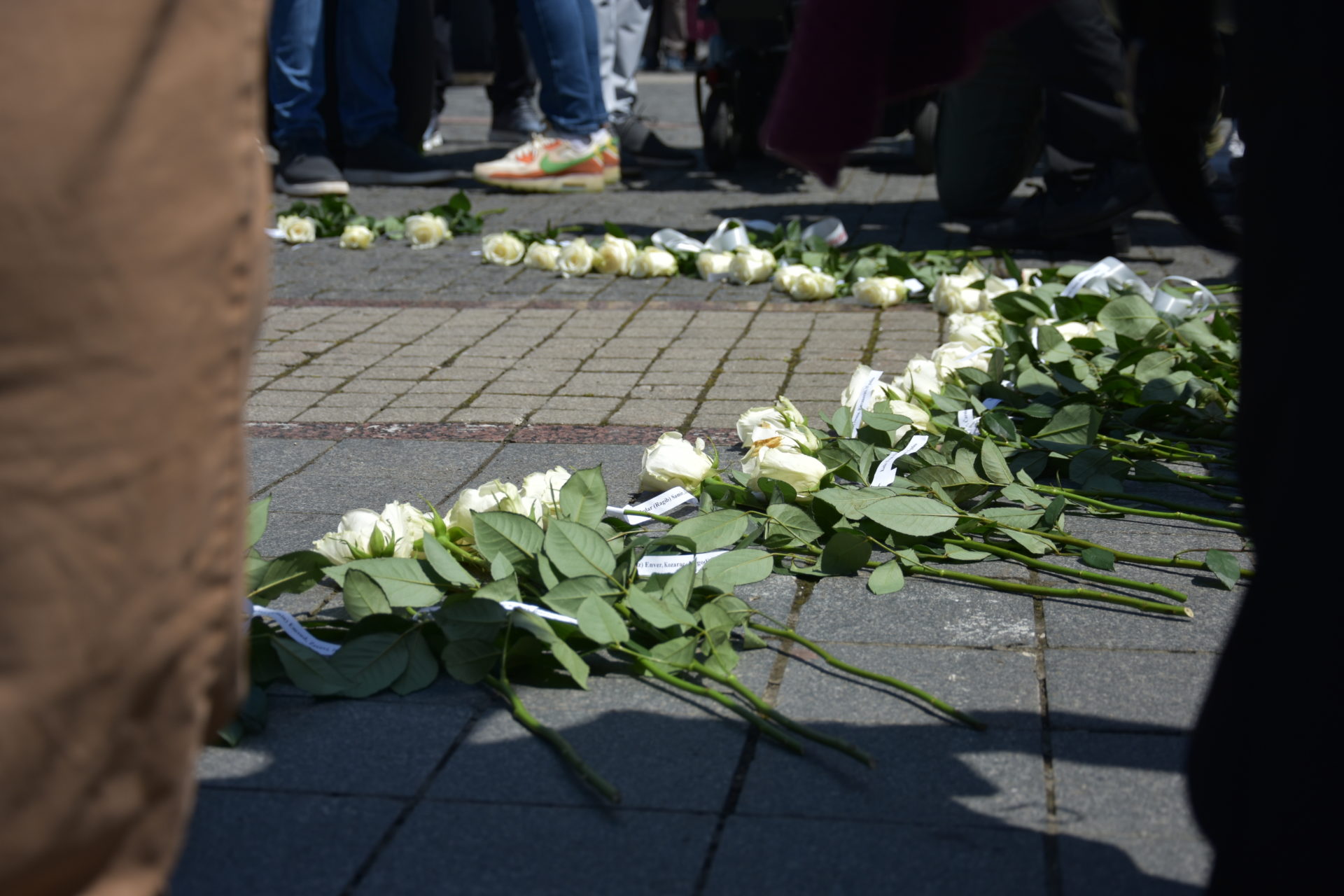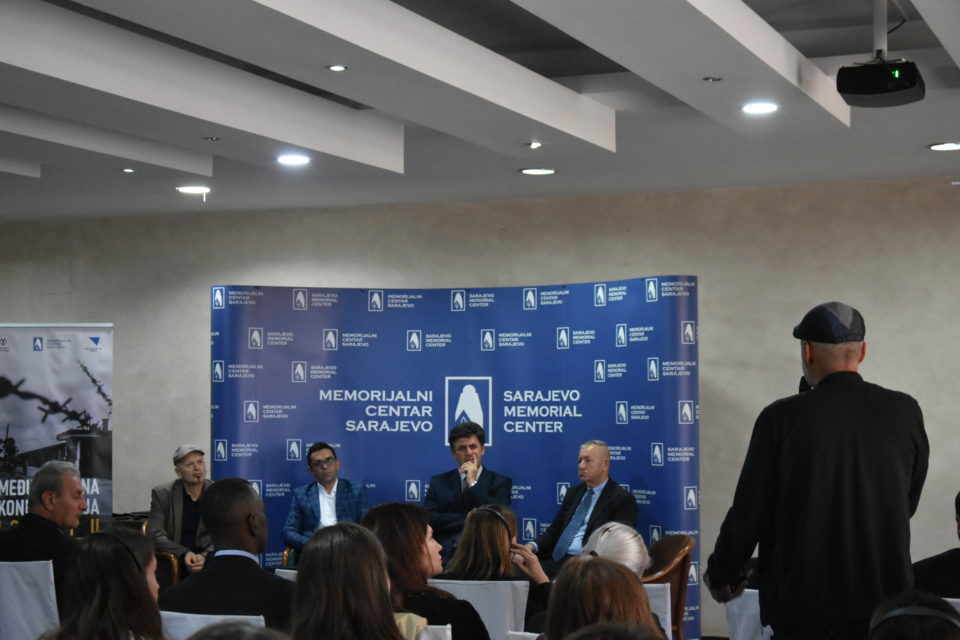
Last month, the Post Conflict Research Center and Sarajevo Memorial Center organized the inaugural International Youth School Prijedor in May 2024. The school included a visit to the Tomašica mass grave, an international conference on the use of detention camps, and participation in the White Armband Day memorial walk.
May 2024 marks 32 years since Bosnian Serb forces imposed the white armband decree on the non-Serb population of the city of Prijedor, NW Bosnia and Herzegovina (BiH). This event culminated in the murder of 3,173 people, including 102 children, in the concentration camps of Omarska, Keraterm, and Trnopolje (Anti-Dayton Group: 2015). Against this historical backdrop, the Sarajevo Memorial Center and the Post-Conflict Research Center (PCRC) organized the first edition of the International Youth School at Hotel Prijedor from May 29th to 31st, 2024. The event included visits to sites that witnessed the atrocities of the 1990s, such as the Tomašica mass grave and the Trnopolje camp, where a photo exhibition by Bosnian artist Nidal Šaljić was displayed. Additionally, panels were held discussing the use of camps as a systematic mechanism of committing human rights violations, concluding with a solidarity march to commemorate White Armband Day.
Limited Memorialization
Today’s BiH is made up of two entities: The Federation of Bosnia and Herzegovina (FBiH) and the Republika Srpska (RS). None of them have clear regulatory legal framework regarding memorialization. Meanwhile, in the RS entity, the lack of acknowledgment of former sites of atrocities is prevalent. Commemoration measures are undertaken by local initiatives and organizations such as Kvart and Jer me se tiče. Local initiatives working on these issues, including survivor’s organizations, allow for the inclusion of witness testimonies.
Velma Šarić, founder and director of PCRC, stressed in an interview, however, that due to the lack of regulations around memorialization in Bosnia, the memorialization approaches vary greatly, which leads to division among organizations: “You have survivors’ associations with different points of view about what needs to be done.” Šarić, therefore, calls for establishing a state law to regulate memorialization; she highlighted that “it would bring a lot of synergy if there were a law” and would also ensure that memorials are created based on historical facts established by the ICTY.
Memorialization and the lack thereof was a central and recurring theme throughout the Youth School. The school allowed survivors to share their experiences and spread their stories as a form of lived memorialization. During an interview with Dr. Ahmed Kulanić, Director of the Sarajevo Memorial Center, he stressed that “by acknowledging the experiences of victims and survivors honors their memory and contributes to the healing processes within affected communities.” In this sense, as Kulanić explained, the International Youth School Prijedor aims to create an integration space to build a culture of memory in the region by utilizing art, education, survivor testimonies and memorialization of sites of atrocity.

Kulanić explained that the establishment of the youth school was “motivated by the desire to promote education and intercultural understanding among youth in a post-conflict region but also to give the opportunity to international students to learn about Prijedor, as it is usually omitted when learning about war in Bosnia.” He further stated that “the school sought to provide a supportive environment where young people could develop a new perspective and become active, responsible citizens.” He believes that it is critical that young people learn about the history of camps in Bosnia, explaining that “understanding this history helps prevent such atrocities from happening again by fostering empathy, tolerance, and a commitment to human rights.” “By providing young people with an opportunity to learn about the history of Prijedor and Bosnia as a whole, the International Youth School is a building block for developing peace throughout local youth communities”, continued Kulanić.
Tomašica Mass Grave Visit
After the International Youth School Prijedor opening ceremony, Jusuf Arifagić, President of the Association of Former Prison Camp Inmates Kozarac, guided the attendees to the Tomašica mass grave, which was discovered in 2013. Within 79 days, the bodies of 435 people were excavated. They were mostly Bosniaks murdered between 1992 and 1995 in Prijedor’s concentration camps. While walking us through an almost inaccessible path to the mass grave, Arifagić recounted his experience in the Keraterm camp. He noted that, despite the systematic violence he and his companions faced during their internment, he held no resentment nor hatred toward the perpetrators.
International Conference on Camps in Prijedor
Much of the International Youth School was oriented towards the International Conference on Detention Camps in Bosnia and Herzegovina. On May 30th, concentration camp survivors, journalists, researchers, politicians, and young people gathered in Prijedor to discuss different aspects of camp memorialization. Panelists emphasized the importance of promoting dialogue between academia, survivors, journalists, and young people from across the globe to foster reconciliation. The speakers featured high-profile figures, such as Judge Graciela Gatti Santana, President of the International Residual Mechanism for Criminal Tribunals (IRMCT), and the Minister of Foreign Affairs of Bosnia and Herzegovina, Elmedin Konaković. Both highlighted the event’s importance as a tool for preventing the spread of historical revisionism promoted by the Republika Srpska entity regarding the war crimes committed in Prijedor.
In their introductory remarks, Ahmed Kulanić, Seid Omerović (President of the Association of Former Prison Camp Inmates of Bosnia and Herzegovina), and Jusuf Arifagić (President of the Association of Former Prison Camp Inmates Kozarac), stressed that the conference was a major contribution to the struggle toward peace in Bosnia and Herzegovina. The conference marked an essential step in supporting the camp survivors by giving them the space to share their stories with an audience of policymakers, young people, and NGOs.
Media Reporting and Societal Memory
In the first panel, the discussants shared their perspectives on the role of media reporting in the documentation of atrocities committed in the Prijedor concentration camps. Erna Mačkić, journalist and advisor at PCRC, and Peter Maass, an American journalist who reported on the Bosnian War during 1992-1993, highlighted the key role of evidence gathered by journalists in making the prosecution of perpetrators of war crimes possible. “Journalists played an important role in the arrest of Milan Lukić. It was only possible because of those journalists’ testimonies,” Mačkić remarked. She further highlighted that journalistic reporting continues to be essential in trials themselves.
While Mačkić lauded the work of international journalists at the International Criminal Tribunal for the former Yugoslavia (ICTY) trials, she noted the disappointingly small number of Bosnian journalists present at the trials. She further criticized journalists in BiH, Croatia, and Serbia for feeding into propaganda during the war instead of adhering to journalistic standards as they were reporting on war crimes. Nowadays, “there is media coverage only on anniversaries regarding the atrocities committed during the war”, assessed Haris Rovčanin, a journalist at the Balkan Investigative Reporting Network (BIRN). Rovčanin and Mačkić advocated for continued reporting on current issues related to the war crimes of the ’90s.
Dr. Eli Tauber, Director of the Archives of the Jewish Community in Bosnia and Herzegovina, reflected on the stages of genocide that precede the mass killings. He discussed the exclusion of Jews that preceded their mass executions in the Holocaust, stating, “The Holocaust was not only about the extermination camps.” Tauber added that the concentration camps constructed in the Western Balkans during the Holocaust also lack memorialization.
Mačkić, while pessimistic about reforms of school curricula due to differing political agendas in BiH, recommended using the facts established during the ICTY trials in educational workshops for young people, such as the PCRC’s workshops.
Challenges in Memorializing War Crimes in Bosnia
Representatives from academia shared their perspectives and research findings on the conflict and the establishment of memorialization sites. Explaining the ideological foundations used to degrade and marginalize Bosniaks, Sead Selimović, a professor at the Faculty of Philosophy at the University of Tuzla, concluded that the dehumanization of Bosniaks was an essential part of legitimizing the narrative behind the SDS’ perpetration of human rights violations.
Senadin Lavić, a professor at the Faculty of Political Science (University of Sarajevo), gave an overview of the mass graves and camps. He stressed that “there needs to be memorial centers in every place where eradication and extermination projects took place.” Official memorialization sites in BiH are not only missing but often appropriated by revisionists, as described by Hariz Halilović, Professor at RMIT University in Melbourne. He highlighted the example of the monument commemorating “fighters who gave their lives for the establishment of the Republika Srpska” established at Trnopolje, where hundreds of Bosniaks and Bosnian Croats were murdered. While official memorial sites are lacking, Halilović identified alternative ways of essential camp memorialization, such as books published by camp survivors, embodied memories in tattoos, and commemoration throughout the diaspora. Nevertheless, official institutions of memorialization such as archives and museums remain central, Dr. Ahmed Kulanić noted. He presented plans to construct a museum focusing on the concentration camps and stressed the key role of NGOs in preserving the facts established in the ICTY trials.
Survivors’ Voices
In the third panel, camp survivors Rezak Hukanović, Sabiha Turkanović, Muhidin Šarić, Emir Hajdarević, Midheta Kaloper, Sakib Ahmetović, and Almin Dželilović shared their experiences in the ongoing struggle for justice as well as their thoughts on commemorating the camps. There was a consensus among them: commemoration in Bosnia and Herzegovina is insufficient, and it is not due to a lack of survivors sharing their stories, but rather society’s unwillingness to listen that prevents justice from being achieved. The issues of missing persons and the prosecution of war crimes were also discussed. Specifically, the survivors explained that, often, people in the local communities know who committed the atrocities, but authorities fail to act upon that information.
Sakib Ahmetović recounted an arson case that took place in his town of Bratunac during the war. He told the conference that everyone in town knew who the arsonist was, yet authorities failed to investigate. Additionally, Almin Đelilović explained that missing persons “are not missing; we know where they were taken.” Ahmetović added, “I know who took my sister, I know where they took her.”
Multiple survivors voiced their disappointment in political actors who have hindered the creation of memorials and increased accessibility to camp sites and mass graves. Midheta Kaloper, an advocate for rape survivors and a survivor herself, criticized the lack of memorials specifically for those who were raped. Nevertheless, she believes there will be justice “if people do their work.” The recently enacted UN resolution on the Srebrenica genocide, she said, gave her hope for the future.
Not everyone was as optimistic. Considering the treatment of survivors thus far, Almin Dželilović contended, “I do not trust there will be justice.” Nevertheless, the panelists agreed to continue their fight. Rezak Hukanović pointed out that more than 20 books on the camps have been published and expressed his wish for a library to be established in Prijedor where these books could become easily accessible. Considering the unwillingness of the Republika Srpska authorities to support the memorialization of the camps, it would certainly be difficult, if not impossible, to create such a library in Prijedor’s current political climate. Muhidin Šarić wrote a book, Keraterm, on his detainment at that camp. Rezak Hukanović wrote about his time at the Omarska concentration camp in the book The Tenth Circle of Hell.
White Armband Day
On Friday, May 31st, the civilian initiative Jer me se tiče organized the annual memorial march of White Armband Day. This day commemorates the lives lost within the Prijedor region from 1992-1995. During the Bosnian War, non-Serb civilians were forced to display a white flag outside their homes and wear a white armband in public as a form of identification that facilitated the detention and murder of many of these civilians.
In 2012, Emir Hodžić stood in the city square bearing a white armband to promote discussion and commemoration, commencing what has since become an annual day of remembrance (Panic & Muslimovic: 2019). This year, participants ranged from Prijedor locals, government officials, reporters, students, and supporters worldwide, including International Youth School Prijedor attendees. Participants wore a white armband and marched to the city center, where the names and ages of the 102 children killed were read off. The memorial march represented the impact that organized memorialization can have on a local community.
To Know the History of Prijedor
The International Youth School Prijedor was notably one of the first times reporters, academics, and survivors had the opportunity to share their stories and perspectives on the atrocities perpetrated within the region. All community members must create room for testimonies to allow the memorialization process to begin locally and throughout Bosnia and Herzegovina. The state has to create the legal framework for this process to facilitate cooperation between organizations and prevent the appropriation of memorials, as Velma Šarić stressed. While combating the lack of memorialization is a long-term process that does not end with the Youth School, through their panel discussions, survivors, academics, and journalists have taken a step toward finding a common language around memorialization practices.
Ahmed Kulanić is determined to increase the reach of the Youth School in the coming years: “We would like to see more students and attract additional professors and experts. The school plans to incorporate more site visits to historical locations and hands-on learning experiences to deepen students’ understanding of Prijedor’s history.”
—————-
This text was created with the support of the “SMART Balkans – Civil Society for Shared Society in the Western Balkans” regional project implemented by the Centar za promociju civilnog društva (CPCD), Center for Research and Policy Making (CRPM) and Institute for Democracy and Mediation (IDM) and financially supported by the Norwegian Ministry of Foreign Affairs (NMFA). The content of the publication is the sole responsibility of the project implementers and does not necessarily reflect the views of the Norwegian Ministry of Foreign Affairs (NMFA) or SMART Balkans consortium partners.








